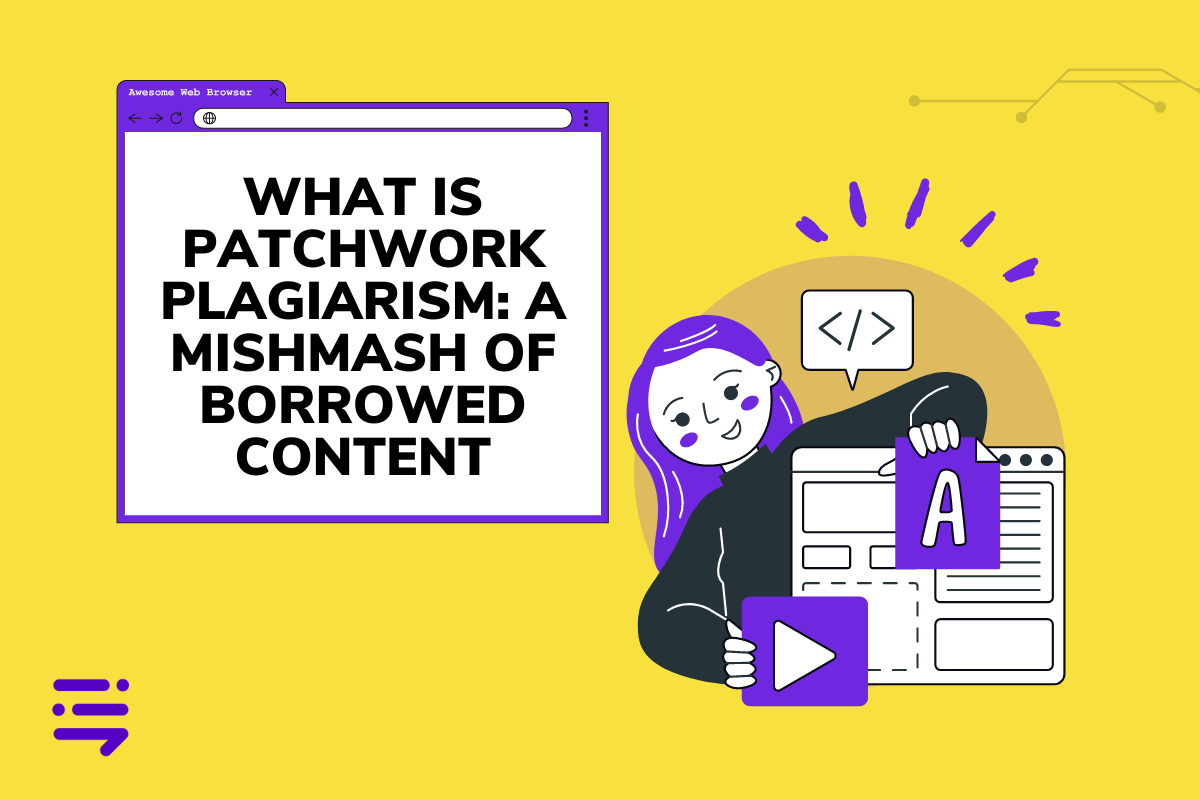Discover top guides, trends, tips and expertise from AIO Writers
What Is Patchwork Plagiarism: A Mishmash of Borrowed Content
Julia McCoy
Friday, 21st Jun 2024
In the world of academic writing and content creation, maintaining originality is paramount. This brings us to the concept of plagiarism – the act of using someone else’s work without giving them proper credit.
But did you know there’s a sneaky form of plagiarism called “patchwork plagiarism” that often flies under the radar?
What is patchwork plagiarism?
It’s like piecing together a quilt using fabric scraps from different sources, except instead of fabric, you’re using words, phrases, and ideas.
Essentially, it involves copying from various sources and stitching them together to create something that might appear original, but really, it’s just a mishmash of borrowed content.
We are going to break it all down so you have a much better idea of how to avoid plagiarism in this sneaky form.
Table Of Contents:
- What is Patchwork Plagiarism?
- Examples of Patchwork Plagiarism
- Repercussions of Patchwork Plagiarism
- How to Spot Patchwork Plagiarism in Your Writing
- Best Practices for Using Sources Ethically
- FAQs: What Is Patchwork Plagiarism?
- Conclusion
What is Patchwork Plagiarism?
Imagine reading a research paper that flows seamlessly from one point to another. But, upon closer inspection, you realize that the paper cleverly combines sentences and paragraphs lifted directly from different sources.
That is patchwork plagiarism in action.
Why Patchwork Plagiarism is a Problem
Although patchwork plagiarism may seem less severe because it involves multiple sources, it’s still a breach of academic integrity.
Here’s why:
- It Misrepresents Your Skills: By piecing together the work of others, you’re essentially taking credit for their ideas and effort.
- It Damages Your Reputation: Getting caught engaging in any form of plagiarism — in this case, mosaic plagiarism — can tarnish your academic and professional reputation, leading to serious consequences like failing grades, academic probation, or even expulsion.
- It Hinders True Learning: Instead of taking the time to process information and develop your original ideas, patchwork plagiarism encourages shortcuts that undermine true learning and critical thinking skills.
Examples of Patchwork Plagiarism
Consider the following example of patchwork plagiarism:
Science is a global endeavor that transcends national boundaries. It is the highest expression of human intelligence and curiosity, illuminating the world with its discoveries. The nation that advances the frontiers of scientific thought and innovation will remain at the forefront of progress.
This passage may appear original at first glance, but it is actually a combination of phrases from Louis Pasteur’s famous quote:
Science knows no country because knowledge belongs to humanity and is the torch which illuminates the world. Science is the highest personification of the nation because that nation will remain the first which carries the furthest the works of thought and intelligence.
By rearranging the words and making minor alterations, the patchwork plagiarist attempts to pass off the content as their own without acknowledging the original source.
This form of patchwriting is a serious breach of academic integrity and can lead to severe consequences for students and professionals alike.
Repercussions of Patchwork Plagiarism
Engaging in patchwork plagiarism can lead to dire consequences for students and professionals alike. Educational institutions and employers take this form of academic dishonesty very seriously, and the penalties can be severe.
Academic Consequences
In the academic world, the consequences of patchwork plagiarism can be devastating. Depending on the severity of the offense and the institution’s policies, students may face:
- Significant grade reductions
- Course failure
- Suspension or expulsion from the institution
- Permanent marks on their academic record
These penalties can have long-lasting effects on a student’s future academic and professional opportunities, as many graduate programs and employers closely scrutinize academic integrity.
Professional Repercussions
The consequences of patchwork plagiarism extend beyond the classroom. In professional settings, individuals who engage in this unethical practice risk:
- Loss of credibility and reputation
- Termination of employment
- Legal action, such as copyright infringement lawsuits
- Difficulty securing future employment due to damaged professional integrity
In the digital age, the consequences of plagiarism can be even more far-reaching. Search engines like Google penalize websites that contain plagiarized content, causing them to rank lower in search results and reducing their visibility to potential readers or customers.
Moreover, original authors whose work has been plagiarized may take legal action, leading to costly fines and settlements for the offender. The reputational damage caused by plagiarism can be irreparable, affecting an individual’s professional standing and future career prospects.
How to Spot Patchwork Plagiarism in Your Writing
Recognizing the signs of patchwork plagiarism in your writing is the first step to avoiding it.
Let’s dive into some red flags:
- Overreliance on Quotations: While quotations are valuable tools for supporting your points, too many direct quotes, even if cited correctly, can be a red flag for patchwork plagiarism.
- Lack of Original Thought: Do you find your arguments are heavily reliant on simply rearranging existing information? This might indicate that you haven’t fully processed the material and developed your own insights.
- Inconsistent Writing Style: Does a particular paragraph or section feel out of sync with your writing? It’s important to pay attention to your gut feeling because if something feels off, it just might be.
Best Practices for Using Sources Ethically
When writing a research paper or academic essay, it’s essential to use reliable sources to support your arguments and provide credibility to your work. However, using these sources incorrectly can lead to patchwork plagiarism.
To avoid this, follow these best practices for using sources ethically:
Cite Sources Correctly
Each time you incorporate a fact, idea, or phrase, give credit to the original material. Stick to the same citation format consistently because trust me, those little details matter.
Always cite your sources according to the required citation style such as APA, MLA, or Chicago. This ensures that you give credit to the original authors and allows readers to locate the sources you used. Use citation management tools like Zotero or Mendeley to organize your references and generate accurate citations.
Add Your Original Ideas
While sources are essential for supporting your arguments, your work should also include your own insights, analysis, and conclusions.
Use sources to provide background information, evidence, and different perspectives, but make sure to contribute your own original thoughts to the discussion.
This helps to differentiate your work from the sources you used and showcases your critical thinking skills.
Master the Art of Note-Taking: Your Secret Weapon
Don’t underestimate the power of effective note-taking. Use your own words when jotting down information. Organize those notes meticulously to easily remember which ideas came from which sources.
Paraphrasing: The Power of Your Own Words
Paraphrasing is all about rewriting information from a source using your own words while still giving credit where it’s due. You want to change the exact phrases but keep the original meaning intact.
Acknowledging the original author is critical for successful and ethical paraphrasing in your work.
Embrace Quotation Marks, but Don’t Overdo It
Direct quotations have their place but should be used strategically. Remember, less is more, and it’s best to use them when a concept is said in such a brilliant way that trying to reword it would dull the effect.
Run a Plagiarism Check
Plagiarism checkers, especially ones with access to massive databases like BrandWell, can compare your work against a huge number of sources.
These tools can identify passages that might need some reworking to avoid any plagiarism issues — ensuring your work is as original as possible.
How do you use BrandWell to spot patchwork plagiarism?
- Open the BrandWell Plagiarism Checker on your browser.
- Paste your text or upload a file.
- Click the “Check Plagiarism” button to run a scan.




FAQs: What Is Patchwork Plagiarism?
What is a patchwork plagiarism example?
Let’s say you’re researching the impact of social media on marketing strategies. You find compelling arguments in different articles, like one suggesting social media humanizes brands, and another emphasizing its role in targeted advertising. You decide to combine these ideas into a paragraph in your essay, presenting them as your own without giving credit to either source.
What is an example of patchwork?
Imagine reading a historical account that appears seamlessly put together. But then you realize it combines paragraphs taken directly from two different historians’ books. The writer has simply rearranged those paragraphs to create a new narrative. That is patchwriting – borrowing phrases, sentences, or entire passages from various sources and fitting them together to craft something new without properly crediting the original authors.
Why is patchwork plagiarism bad?
Although it may appear as a more subtle form of academic dishonesty, patchwork plagiarism still misrepresents your skills and can harm your academic journey. It gives the impression that you’re passing off other people’s thoughts as your own which calls your credibility into question.
Conclusion
So, there you have it. You now know exactly what is patchwork plagiarism and how to steer clear of it.
With a bit of extra effort, a keen eye for detail, and those savvy strategies up your sleeve you’ll be churning out ethical, original, and plagiarism-free content in no time.

UNLOCK YOUR POTENTIAL
Long Headline that highlights Value Proposition of Lead Magnet
Grab a front row seat to our video masterclasses, interviews, case studies, tutorials, and guides.



